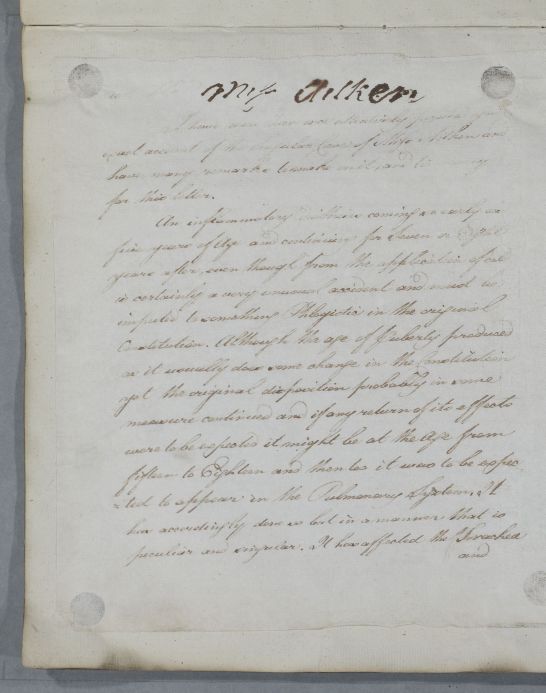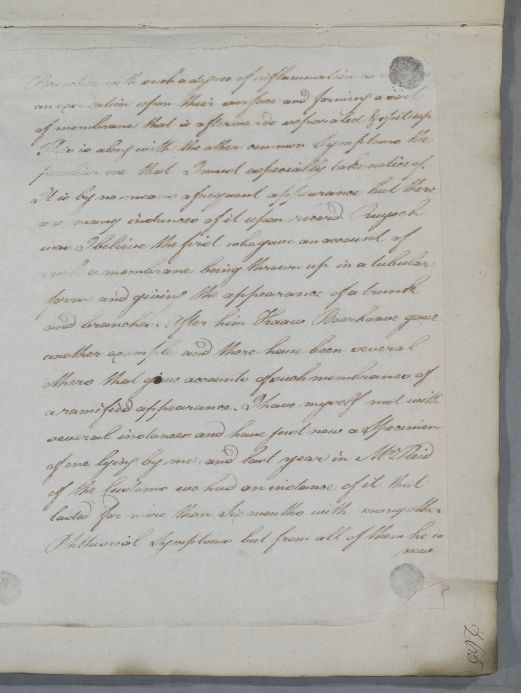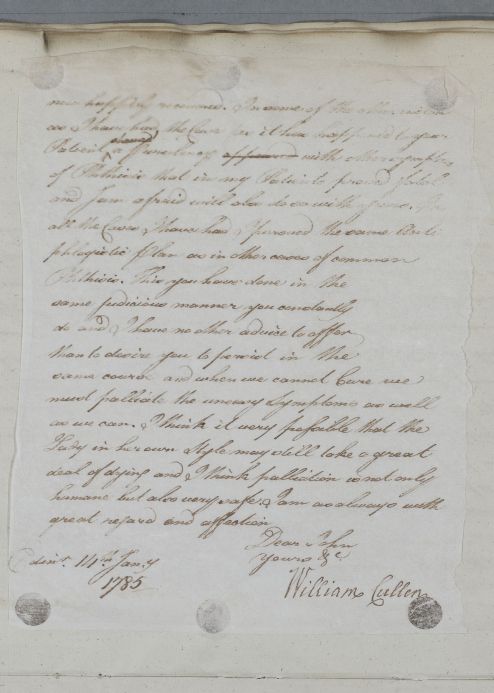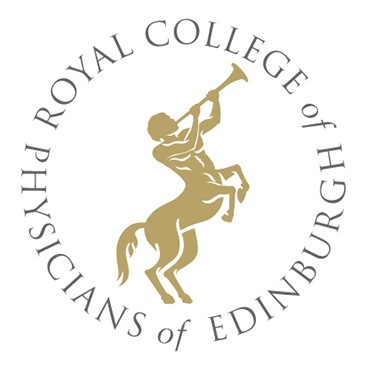
The Consultation Letters of Dr William Cullen (1710-1790) at the Royal College of Physicians of Edinburgh
[ID:4968] From: Dr William Cullen (Professor Cullen) / To: Dr John Gilchrist (of Speddoch) / Regarding: Miss Aitken (Patient), Mr Reid (Patient) / 14 January 1785 / (Outgoing)
Reply concerning the case of Miss Aitken,. Cullen fears she is incurable but she may "take a great deal of dying". Cullen refers to the works of Ruysch and Boerhaave's nephew Kaau. He also mentions a Mr Reid of the Customs, that he treated the previous year with Phthisical Symptoms (not found in consultations, but probably a local patient visited in person).
- Facsimile
- Normalized Text
- Diplomatic Text
- Metadata
- Case
- People
- Places
Facsimile
There are 3 images for this document.

[Page 1]

[Page 2]

[Page 3]
Metadata
| Field | Data |
|---|---|
| DOC ID | 4968 |
| RCPE Catalogue Number | CUL/1/1/17/162 |
| Main Language | English |
| Document Direction | Outgoing |
| Date | 14 January 1785 |
| Annotation | None |
| Type | Machine copy |
| Enclosure(s) | No enclosure(s) |
| Autopsy | No |
| Recipe | No |
| Regimen | No |
| Letter of Introduction | No |
| Case Note | No |
| Summary | Reply concerning the case of Miss Aitken,. Cullen fears she is incurable but she may "take a great deal of dying". Cullen refers to the works of Ruysch and Boerhaave's nephew Kaau. He also mentions a Mr Reid of the Customs, that he treated the previous year with Phthisical Symptoms (not found in consultations, but probably a local patient visited in person). |
| Manuscript Incomplete? | No |
| Evidence of Commercial Posting | No |
Case
Cases that this document belongs to:
| Case ID | Description | Num Docs |
|---|---|---|
| [Case ID:1410] |
Case of Miss Aitken who has a long-standing, intermittent, painful chest complaint. |
5 |
People linked to this document
| Person ID | Role in document | Person |
|---|---|---|
| [PERS ID:1] | Author | Dr William Cullen (Professor Cullen) |
| [PERS ID:115] | Addressee | Dr John Gilchrist (of Speddoch) |
| [PERS ID:2748] | Patient | Miss Aitken |
| [PERS ID:4355] | Patient | Mr Reid |
| [PERS ID:115] | Patient's Physician / Surgeon / Apothecary | Dr John Gilchrist (of Speddoch) |
| [PERS ID:1] | Patient's Physician / Surgeon / Apothecary | Dr William Cullen (Professor Cullen) |
| [PERS ID:4354] | Other Physician / Surgeon | Professor Frederik Ruysch |
Places linked to this document
| Role in document | Specific Place | Settlements / Areas | Region | Country | Global Region | Confidence |
|---|---|---|---|---|---|---|
| Place of Writing | Cullen's House / Mint Close | Edinburgh | Edinburgh and East | Scotland | Europe | certain |
| Destination of Letter | Dumfries | Borders | Scotland | Europe | inferred |
Normalized Text
Miss Aitken
I have more than once attentively found your
exact account of the Singular Case of Miss Aitken and
have many remarks to make on it, and too many
for this letter.
An inflammatory diathesis coming so easily [at?]
five years of Age and continuing for Seven or Eight
years after, even though from the application of cold
is certainly a very unusual accident and must be
imputed to something Phlogistic in the original
Constitution. Although the age of Puberty produced
as it usually does some change in the Constitution
yet the original disposition probably in some
measure continued and if any return of its effects
were to be expected it might be at the Age from
fifteen to Eighteen and then too it was to be expec¬
ted to appear in the Pulmonary System. It
has accordingly done so but in a manner that is
peculiar and singular. It has affected the Trachea
and
[Page 2]
Branches with such a degree of inflammation as {illeg}
an exsudation upon their [surface?] and forming a [sort?]
of membrane that is afterwards separated & [spit?] up
This is along with the other common Symptoms the
peculiar one that I must especially take notice of.
It is by no means a frequent appearance but there
are many instances of it upon record. Ruysch 1
was I believe the first who gave an account of
such a membrane being thrown up in a tubular
form and giving the appearance of a trunk
and branches. After him Kaaw Boerhaave 2 gave
another example and there have been several
others that give accounts of such membranes of
a ramified appearance. I have myself met with
several instances and have just now a Specimen
of one lying by me, and last year in Mr Reid
of the Customs we had an instance of it that
lasted for more than Six months with many other
Phthisical Symptoms but from all of them he is
[Page 3]
now happily [recovered?]. 3 In some of the other instan¬
ces I have had the Case as it how happened and to your
Patient ↑[shewed?]↑ a {illeg} appeared with other symptoms
of Phthisis that in my Patients proved fatal
and I am afraid will also do with yours. In
all the Cases I have had {illeg} the same Anti
phlogistic Plan as in other cases of common
Phthisis. This you have done in the
same judicious manner you constantly
do and I have no other advice to offer
than to desire you to persist in the
same course and when we cannot Cure we
must palliate the uneasy Symptoms as well
as we can. I think it very possible that the
Lady in her own Style may still take a great
deal of dying and I think palliation is not only
humane but also very safe. I am as always with
great regard and affection
Dear John
Yours &c.
Edinburgh 14th. January
1785/
Notes:
1: Frederik Ruysch (March 28, 1638 – February 22, 1731), a Dutch botanist and anatomist. The precise printed source amongst his large body of publications untraced.
2: Precise source untraced, but Kaaw [Kaau] Abrahamus Boerhaave, published several medical works in latin between 1738 and 1757. Abraham Kaau Boerhaave (also Abrahamus and Kauuw Boerhaave) (1715 -1758), was a Dutch doctor who in 1746 moved to Russia where he became professor of anatomy and physiology at the Russian Academy of Sciences in St. Petersburg. He was the son of the physician Jacob Kaau (1658-1728) and Margariet Boerhaave (1670-1754) and studied at Leiden University under his uncle, the famous Herman Boerhaave. Cullen mentions Kaau's medical ideas occasionally in his own textbooks.
3: No evidence of this case traced in the archive, but Cullen probably saw him in person as he was local.
Diplomatic Text
Miss Aitken
I have more than once attentively found your
exact account of the Singular Case of Miss Aitken and
have many remarks to make on it, and too many
for this letter.
An inflammatory diathesis coming so easily [at?]
five years of Age and continuing for Seven or Eight
years after, even though from the application of cold
is certainly a very unusual accident and must be
imputed to something Phlogistic in the original
Constitution. Although the age of Puberty produced
as it usually does some change in the Constitution
yet the original disposition probably in some
measure continued and if any return of its effects
were to be expected it might be at the Age from
fifteen to Eighteen and then too it was to be expec¬
ted to appear in the Pulmonary System. It
has accordingly done so but in a manner that is
peculiar and singular. It has affected the Trachea
and
[Page 2]
Branches with such a degree of inflammation as {illeg}
an exsudation upon their [surface?] and forming a [sort?]
of membrane that is afterwards separated & [spit?] up
This is along with the other common Symptoms the
peculiar one that I must especially take notice of.
It is by no means a frequent appearance but there
are many instances of it upon record. Ruysch 1
was I believe the first who gave an account of
such a membrane being thrown up in a tubular
form and giving the appearance of a trunk
and branches. After him Kaaw Boerhaave 2 gave
another example and there have been several
others that give accounts of such membranes of
a ramified appearance. I have myself met with
several instances and have just now a Specimen
of one lying by me, and last year in Mr Reid
of the Customs we had an instance of it that
lasted for more than Six months with many other
Phthisical Symptoms but from all of them he is
[Page 3]
now happily [recovered?]. 3 In some of the other instan¬
ces I have had the Case as it how happened and to your
Patient ↑[shewed?]↑ a {illeg} appeared with other symptoms
of Phthisis that in my Patients proved fatal
and I am afraid will also do with yours. In
all the Cases I have had {illeg} the same Anti
phlogistic Plan as in other cases of common
Phthisis. This you have done in the
same judicious manner you constantly
do and I have no other advice to offer
than to desire you to persist in the
same course and when we cannot Cure we
must palliate the uneasy Symptoms as well
as we can. I think it very possible that the
Lady in her own Style may still take a great
deal of dying and I think palliation is not only
humane but also very safe. I am as always with
great regard and affection
Dear John
Yours &c.
Edinr. 14th. Jany.
1785/
Notes:
1: Frederik Ruysch (March 28, 1638 – February 22, 1731), a Dutch botanist and anatomist. The precise printed source amongst his large body of publications untraced.
2: Precise source untraced, but Kaaw [Kaau] Abrahamus Boerhaave, published several medical works in latin between 1738 and 1757. Abraham Kaau Boerhaave (also Abrahamus and Kauuw Boerhaave) (1715 -1758), was a Dutch doctor who in 1746 moved to Russia where he became professor of anatomy and physiology at the Russian Academy of Sciences in St. Petersburg. He was the son of the physician Jacob Kaau (1658-1728) and Margariet Boerhaave (1670-1754) and studied at Leiden University under his uncle, the famous Herman Boerhaave. Cullen mentions Kaau's medical ideas occasionally in his own textbooks.
3: No evidence of this case traced in the archive, but Cullen probably saw him in person as he was local.
XML
XML file not yet available.
Feedback
Send us specfic feeback about this document [DOC ID:4968]
Please note that the Cullen Project team have now disbanded but your comments will be logged in our system and we will look at them one day...


